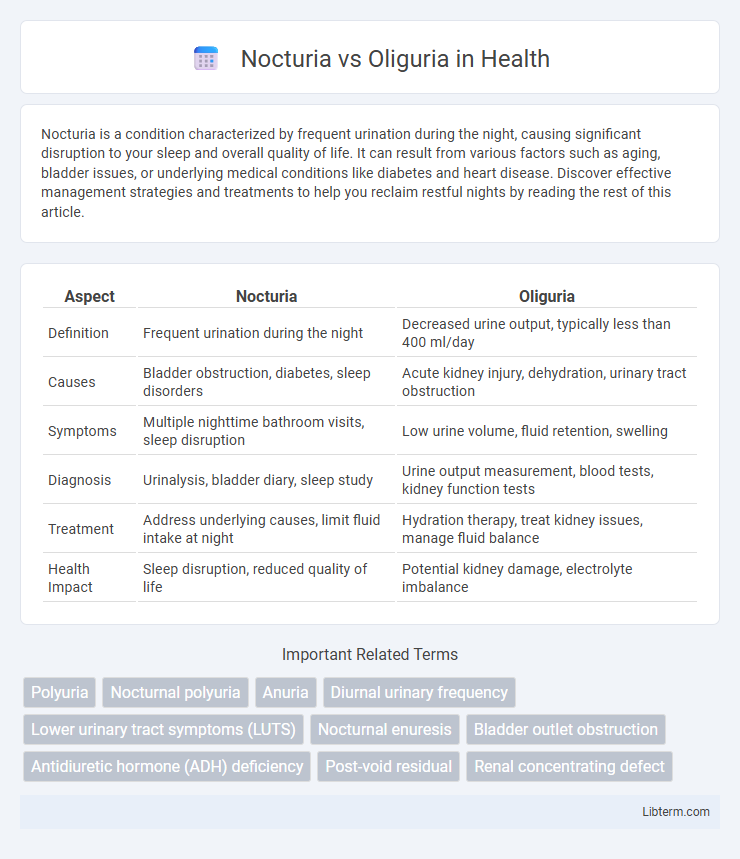Nocturia is a condition characterized by frequent urination during the night, causing significant disruption to your sleep and overall quality of life. It can result from various factors such as aging, bladder issues, or underlying medical conditions like diabetes and heart disease. Discover effective management strategies and treatments to help you reclaim restful nights by reading the rest of this article.
Table of Comparison
| Aspect | Nocturia | Oliguria |
|---|---|---|
| Definition | Frequent urination during the night | Decreased urine output, typically less than 400 ml/day |
| Causes | Bladder obstruction, diabetes, sleep disorders | Acute kidney injury, dehydration, urinary tract obstruction |
| Symptoms | Multiple nighttime bathroom visits, sleep disruption | Low urine volume, fluid retention, swelling |
| Diagnosis | Urinalysis, bladder diary, sleep study | Urine output measurement, blood tests, kidney function tests |
| Treatment | Address underlying causes, limit fluid intake at night | Hydration therapy, treat kidney issues, manage fluid balance |
| Health Impact | Sleep disruption, reduced quality of life | Potential kidney damage, electrolyte imbalance |
Introduction to Nocturia and Oliguria
Nocturia is characterized by frequent urination during the night, disrupting sleep and often linked to conditions such as diabetes, bladder infections, or prostate enlargement. Oliguria refers to abnormally low urine output, typically less than 400 milliliters per day in adults, and may indicate dehydration, kidney failure, or urinary tract obstruction. Identifying the differences between nocturia and oliguria is crucial for diagnosing underlying renal or urological disorders.
Defining Nocturia: Causes and Symptoms
Nocturia is characterized by frequent urination during the night, disrupting sleep and often caused by factors such as excessive fluid intake, bladder infections, diabetes, or prostate issues. Symptoms include waking up multiple times to urinate, nocturnal polyuria, and sometimes associated pelvic discomfort. Unlike oliguria, which involves significantly reduced urine output, nocturia primarily relates to the timing and frequency of urination rather than volume reduction.
Understanding Oliguria: Clinical Presentation
Oliguria is clinically defined as urine output less than 400 milliliters per day in adults, often indicating underlying renal dysfunction or fluid imbalance. Patients with oliguria typically present with signs of fluid retention, such as edema, elevated blood pressure, and decreased urine output, which contrasts with nocturia characterized by frequent nighttime urination. Recognizing oliguria is critical for early diagnosis of acute kidney injury, dehydration, or urinary obstruction, guiding timely intervention and management.
Key Differences Between Nocturia and Oliguria
Nocturia is characterized by frequent urination during the night, typically causing sleep disturbances, whereas oliguria involves producing an abnormally low volume of urine, usually less than 400 milliliters per day. Nocturia often results from conditions like bladder infections, diabetes, or excessive fluid intake before bedtime, while oliguria is commonly linked to acute kidney injury, dehydration, or urinary obstruction. The primary diagnostic difference lies in urine output patterns: nocturia reflects increased nighttime urination frequency, while oliguria indicates a significant reduction in total urine volume.
Primary Causes of Nocturia
Nocturia primarily results from conditions that increase urine production at night, such as nocturnal polyuria, which is commonly caused by heart failure, diabetes mellitus, and sleep apnea. Other primary causes include bladder storage problems like overactive bladder syndrome and lower urinary tract obstruction. In contrast, oliguria is characterized by decreased urine output due to reduced kidney perfusion, acute kidney injury, or severe dehydration.
Main Etiologies of Oliguria
Oliguria, defined as urine output less than 400 mL per day in adults, commonly results from acute kidney injury, hypovolemia, or urinary tract obstruction, with main etiologies including prerenal causes like dehydration and heart failure, intrinsic renal damage such as acute tubular necrosis, and postrenal obstruction from stones or strictures. In contrast, nocturia involves excessive urination at night and is often linked to factors like nocturnal polyuria, bladder dysfunction, or systemic conditions including diabetes and benign prostatic hyperplasia. Understanding oliguria's underlying etiologies is critical for timely diagnosis and treatment to prevent progression to renal failure.
Diagnostic Approaches for Nocturia
Nocturia diagnosis involves detailed patient history, frequency-volume charts, and evaluation of nocturnal urine output to differentiate it from other causes such as Oliguria. Diagnostic approaches include urinalysis, bladder diary, post-void residual measurement, and assessment of underlying conditions like diabetes or sleep disorders. Polysomnography and renal function tests may be employed to identify contributing factors and optimize treatment strategies.
Diagnostic Methods for Oliguria
Oliguria is diagnosed primarily through measurement of urine output, typically less than 400 mL per day for adults, using a catheter or collection device. Laboratory assessments including blood urea nitrogen (BUN), serum creatinine, and electrolyte levels help evaluate renal function and identify potential causes. Imaging studies like renal ultrasound may be employed to detect obstructions or anatomical abnormalities contributing to reduced urine production.
Treatment Options for Nocturia and Oliguria
Treatment options for nocturia focus on lifestyle modifications such as fluid restriction before bedtime and addressing underlying causes like bladder overactivity with anticholinergic medications or desmopressin to reduce nighttime urine production. Oliguria treatment centers on correcting the underlying cause, including rehydration for dehydration, managing renal insufficiency with medications or dialysis, and addressing urinary obstructions surgically if necessary. Both conditions require accurate diagnosis through urine output measurement and evaluation of renal function to guide targeted therapy effectively.
Prevention Strategies and Lifestyle Modifications
Effective prevention strategies for nocturia include reducing evening fluid intake, limiting caffeine and alcohol consumption, and managing underlying conditions like diabetes and heart failure. For oliguria, maintaining adequate hydration and avoiding nephrotoxic medications are critical lifestyle modifications to preserve kidney function. Monitoring daily fluid balance and addressing any urinary tract infections early can help prevent exacerbation of both conditions.
Nocturia Infographic

 libterm.com
libterm.com